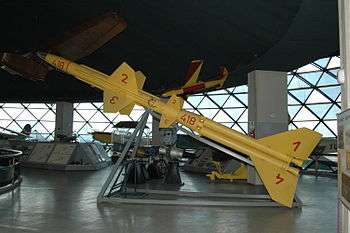R-25 Vulkan
| R-25 Vulkan | |
|---|---|
|
A telemetry-equipped R-25 on display at the Aviation Museum - Belgrade | |
| Type | Surface-to-air missile (SAM) |
| Place of origin |
|
| Production history | |
| Designer | Obrad Vučurović |
| Designed | 1958 onwards |
| Manufacturer | SOKO |
| Number built | 12 |
| Specifications | |
| Weight | 1,413 kg (3,115 lb) at launch |
| Length | 8.10 m (26.6 ft) total length at launch |
| length | 5.24 m (17.2 ft) missile without booster rockets |
| Diameter | 350 mm (14 in) |
|
| |
| Engine |
RM-1000B sustainer 11.77 kN (2,650 lbf) thrust - sustainer, 245.25 kN (55,130 lbf) thrust - boosters |
| Propellant | liquid fuel sustainer, solid-fuelled boosters |
Operational range | 30 km (19 mi) |
| Flight altitude | 20 km (12 mi) |
| Speed | M2.5 |
Guidance system | Radar initially with infra-red terminal guidance |
Steering system | Aerodynamic |
The R-25 Vulkan (Serbian: Вулкан - volcano) was a surface-to-air missile (SAM) designed and built in the Socialist Federal Republic of Yugoslavia (SFRY) in the late 1950s and the early 1960s.
Development
The mid-1950s saw the emergence of viable surface-to-air missiles for Air Defence. Due to the inability to import SAM systems Yugoslavia initiated in 1958 a program to develop an indigenous missile, at the Military-technical institute, designated R-25 Vulkan.[1] This completely original Yugoslavian project brought together a team of experts led by engineer Obrad Vučurović to design the missile, with the prototypes being made in the SOKO aircraft factory in Mostar.[1]
Two versions of the missile were developed: one that had a booster-rocket engine with seven rockets and the other with four. Additionally, the experimental samples used liquid fuel rocket engine that has been developed for a rocket-powered torpedo, but it was planned that operational production missiles would use a solid-fueled engine with twice the thrust.[1] Development launcher and radar system were that of Japanese Kappa sounding rocket that was imported in Yugoslavia.[2] Target detection and information collection would be carried out by Yugoslav-made M 61 Fruška Gora radar, and in-course guidance supplied by a US-made 3-M-7 aiming radar.[1] For operational use there existed the possibility of using more sophisticated radar equipment.[1] For terminal guidance the missile would switch to independent homing by infrared sensors in its nose.[1] The advanced guidance system of the R-25 was automatic after launch with no further operator input.[1]
Use
The first launch of the missile was conducted in November 1962, revealing problems with the liquid-fueled sustainer rocket motor.[1] Concurrently with R-25 testing in 1962, the SFRY acquired S-75 Dvina (Russian: С-75; NATO reporting name SA-2 Guideline), missile systems from the Soviet Union.[1] Because of this, at the end of 1964 the decision was made that, after twelve missiles had been produced, work on the project was to be abandoned.[1] However, the knowledge and experience gained on this project and its material basis were incorporated into other projects that have been implemented and introduced into the production of armament for the Yugoslav People's Army (YPA).[1]
Survivors
A single R-25 Vulkan missile is preserved at the Aviation Museum - Belgrade; intended for in-flight testing, the warhead has been replaced by measuring and telemetry equipment.[1]
External links
References
- 1 2 3 4 5 6 7 8 9 10 11 12 "Соко Вулкан (ракета З-В)". Belgrade Museum of Aviation. Retrieved January 18, 2013.
- ↑ Ichiro Matsuo (July 16, 2012). "Japan rocket technologies misused by Yugo military in 1960s". Asahi Shimbun. Retrieved January 18, 2013.
